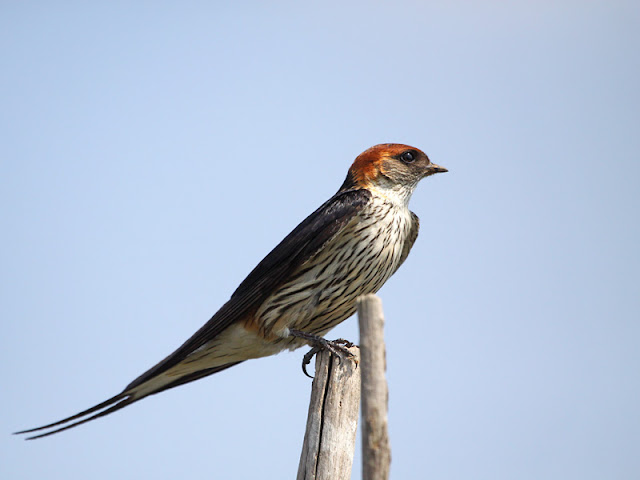At the first hide from the visitors centre I came across some Reed Cormorants perched on the metal poles prtruding from the water, some of which were just waking up by the looks of it!
 |
| Reed Cormorant |
There was not much going on but after sitting for a while some warblers moved past the hide. Amongst them were Lesser Swamp Warbler, African Reed Warbler and a couple of European Sedge Warblers. Next was the otter hide which was occupied so I birded from th road using my vehicle as a hide. Birds spotted along here were White-throated Swallow and the spectacular sight of the huge Barn Swallow roost waking up.
 |
| White-throated Swallow |
 |
| A small section of the vast Barn Swallow flock over the reeds |
There didn't seem to be any waders around but after a bit of scanning I picked up a few Little Stints and amongst them a single Ringed Plover. Normally there are very large flocks of Ruff here but I only found a small handful.
 |
| Little Stints and Ringed Plover in foreground |
On the way to the Picnic site I found a pair of Cape Shovellers, my first for the year. You can distinguish between male and female of this species by the eye colour, the male has a bright yellow eye while the females eye is dark in colour.
 |
| Cape Shovellers |
The picnic sites hide was very quiet with only a few Coots and Moorhens floating around. Several Little Rush Warblers were calling from the thick reed beds. After passing through the gate on the causeway road several Amur Falcons flew over, I checked them carefully for any Western Redfooted Kestrels but with no luck. Amur males have white underwing coverts and Western Redfoots have dark grey underwing coverts.
 |
| Amur Falcon - Male |
At the first hide from the gate there were some breeding Greater Striped Swallows using the hide as a safe and dry location for their nest. They kept flying in and out while we were sitting there and using a pole right in front of the hide as a perch fro serenading and rest.
 |
| Greater Striped Swallow |
African Darters use the poles to the west of this hide for drying out and warming up and some Whiskered and White-winged Black Terns were using the hide as a wind block while they foraged for food. Close fly-pasts allowed some attempts at in-flight photography.
 |
| African Darter |
 |
| Immature Whiskered Tern |
Just before the Bus Stop hide the grasslands were still flooded and teeming with Wood Sandpipers and camera shy African Snipe, Euplectes seedeaters were numerous along this part of the causeway. Red and Yellow-crowned Bishops, Long-tailed, Red-Collared and Fan-tailed Widowbirds, Southern Masked Weavers, Common and Orange-breasted Waxbills and Pin-tailed Whydahs were amongst those identified. A lone African Marsh Harrier hunted over the Reeds.
 |
| Wood Sandpiper |
At the bridge past the Bus Stop hide I normally like to cruise up quietly to see what birds are about in the reeds but there were two birders on foot that had probably chased all away. I nonetheless found an immature Malachite Kingfisher that allowed a close approach for a photo or forty....a lot of people confuse these with the Half-collared Kingfisher which rather prefer wooded stream with fast flowing water.
 |
| Immature Malachite Kingfisher (2) |
After the bridge I carried on to the fence at the mine dumps and then turned to my left to check out the dams at the bottom of the reserve. African Stonechats always hang around here and after several years of battling to get photos of these guys I always try for a shot. They are such stunning little birds with great colours, I even got a photo of the female (don't laugh, we all have our photographic bogey birds).
 |
| Male Stonechat |
 |
| Female Stonechat |
While searching the ponds for any interesting birds I spotted a Cape Clawless Otter hunting in the opposite pond, seemingly oblivious to my presence. After a watching him for a while and getting some record photos, he disappeared behind an island.
 |
| Cape Clawless Otter (2) |
A great ending to a great days birding, I found the waders I had been looking for and even got a lone immature Lesser Flamingo on the ponds below the guest huts for the year list.








































